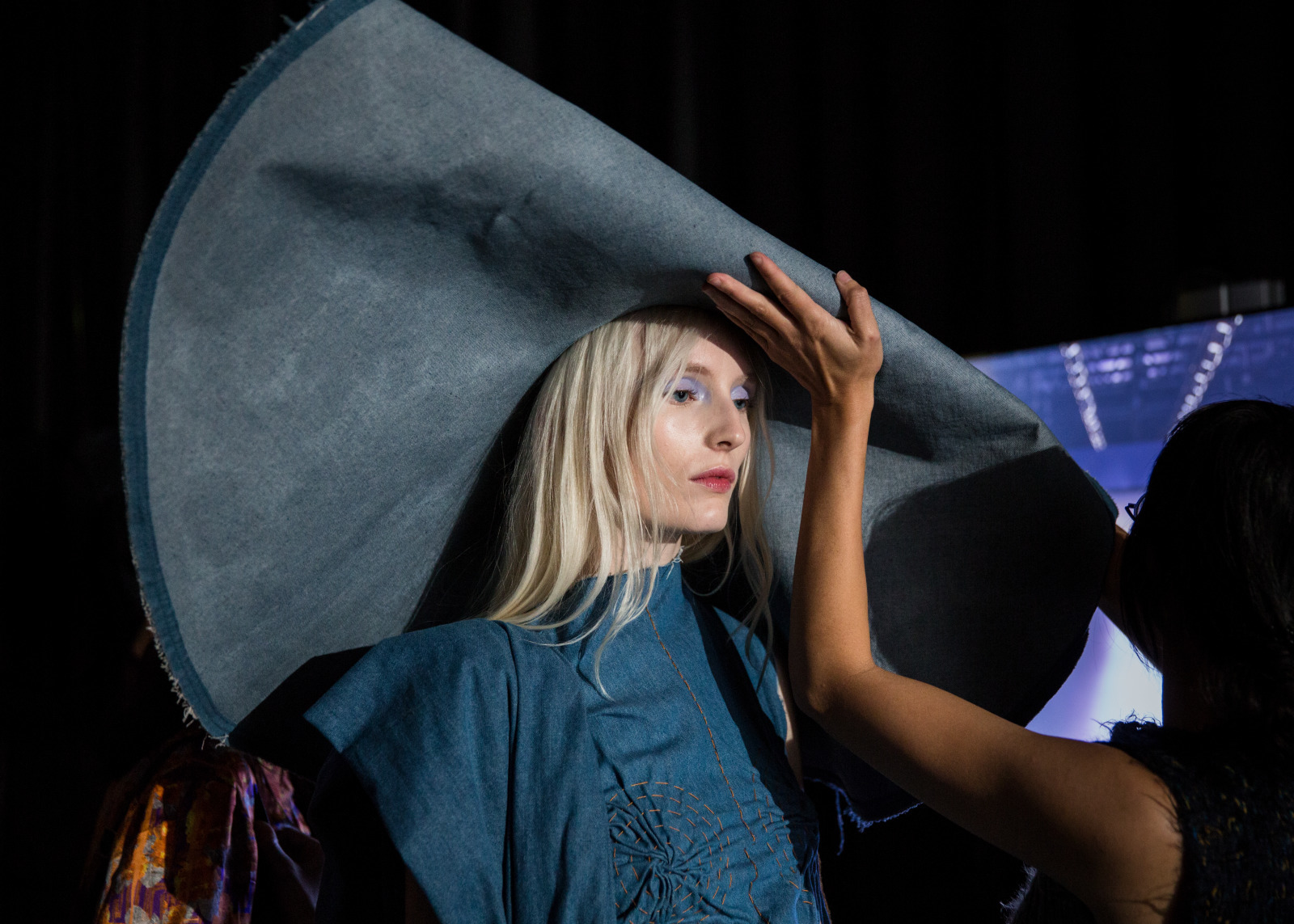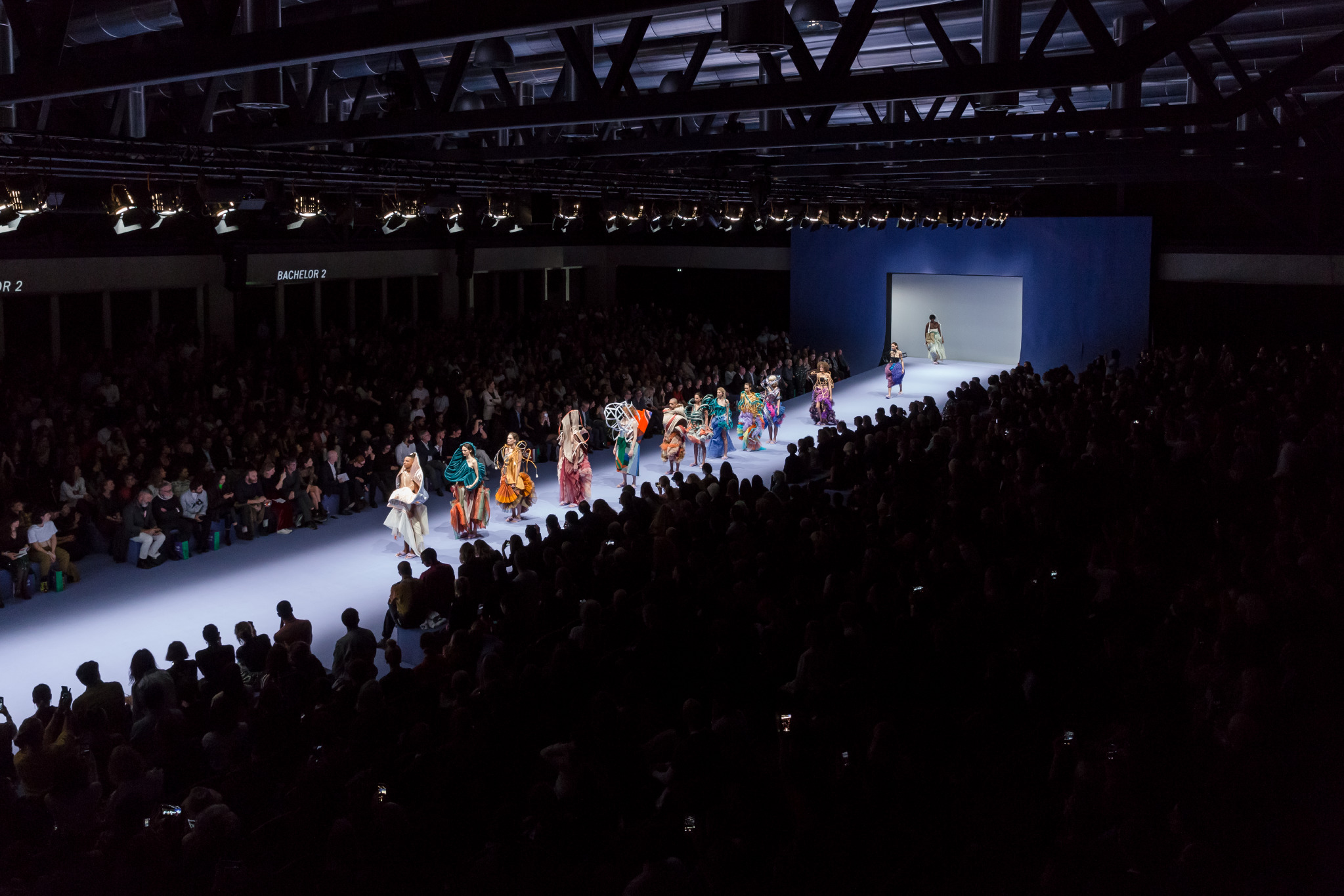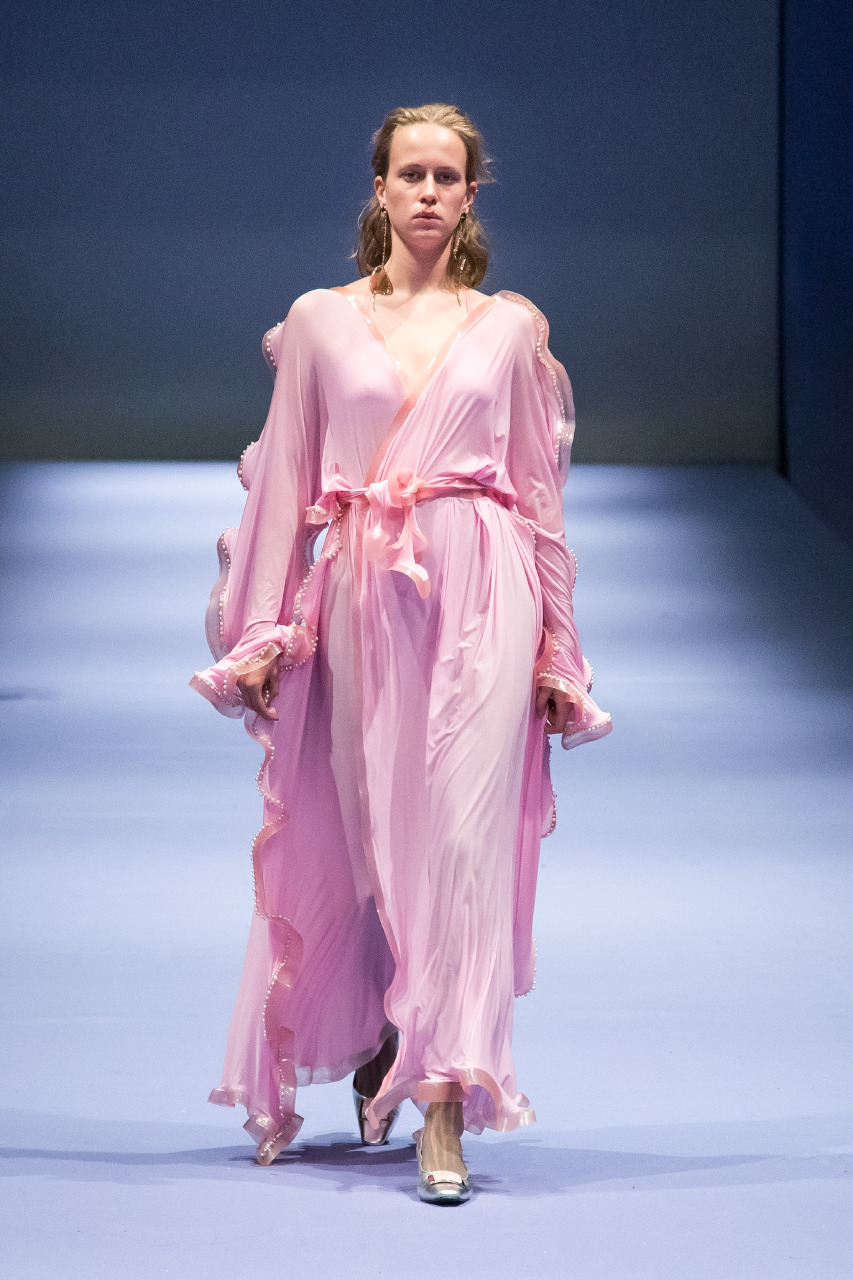HEAD Genève: A Superior Interdisciplinary Education
 Graduate collections are inherently special. It is a privilege to witness the debut of a fresh generation onto the global fashion stage, within a pulsing atmosphere of raw anticipation, pride, youthful anxiety and relief; distinct to such outstanding occasions. Here the creative output, be it clothing or accessories, is defined by the freedom of unrestrained imagination and blossoming craftsmanship, generated over years of practice and guidance from patient lecturers. Strongest collections offer an authentic, bold point of view leaving a memorable impression on the audience.Being based in London, home to the Royal College of Art, Central Saint Martin's and the London College of Fashion among others, I am spoiled to be within the heart of fashion higher education, however it is particularly rewarding to travel abroad and gain insight into the approach of other leading global arts institutions. Earlier this month, I had the pleasure of visiting HEAD Geneva before for its annual Fashion Show and was extremely impressed by not only the state-of-the-art facilities and renowned staff, but its holistic ethos which uniquely prioritises an interdisciplinary approach across the art programmes.
Graduate collections are inherently special. It is a privilege to witness the debut of a fresh generation onto the global fashion stage, within a pulsing atmosphere of raw anticipation, pride, youthful anxiety and relief; distinct to such outstanding occasions. Here the creative output, be it clothing or accessories, is defined by the freedom of unrestrained imagination and blossoming craftsmanship, generated over years of practice and guidance from patient lecturers. Strongest collections offer an authentic, bold point of view leaving a memorable impression on the audience.Being based in London, home to the Royal College of Art, Central Saint Martin's and the London College of Fashion among others, I am spoiled to be within the heart of fashion higher education, however it is particularly rewarding to travel abroad and gain insight into the approach of other leading global arts institutions. Earlier this month, I had the pleasure of visiting HEAD Geneva before for its annual Fashion Show and was extremely impressed by not only the state-of-the-art facilities and renowned staff, but its holistic ethos which uniquely prioritises an interdisciplinary approach across the art programmes. Established in 2006 from the merger between the Ecole supérieure des beaux-arts and the Haute école d’arts appliqués, HEAD Geneva offers both Bachelor’s and Master’s programmes within the fine arts, cinema, spatial design, graphic and media design, jewellery, watch, accessory design and of course fashion. It is remarkable how this public university (being one of the few leading fashion institutions not to charge for education) boasts such a high level of infrastructure, facilities and teaching. Its newly opened campus, designed by architect Georges Addor in 1956 is even classified and registered for Geneva's heritage due to its global influence on modernist and rationalist architecture.
Established in 2006 from the merger between the Ecole supérieure des beaux-arts and the Haute école d’arts appliqués, HEAD Geneva offers both Bachelor’s and Master’s programmes within the fine arts, cinema, spatial design, graphic and media design, jewellery, watch, accessory design and of course fashion. It is remarkable how this public university (being one of the few leading fashion institutions not to charge for education) boasts such a high level of infrastructure, facilities and teaching. Its newly opened campus, designed by architect Georges Addor in 1956 is even classified and registered for Geneva's heritage due to its global influence on modernist and rationalist architecture. Apart from its notable setting, what I admired about HEAD was how it not only encouraged interdisciplinary education, but how this ethos is built directly into a programme's syllabus through collaborative projects within the university and with outside industry partners. Daily, students are automatically confronted with complimenting departments within the campus and are pushed to experiment outside their respective fields. For example a fashion student may experiment in creating ceramics, jewellery, or metal works, thus strengthening a fundamental understanding of materials and technical skills. As a result, graduates gain proficiency in production as well as innovative design, as dramatically displayed at the annual défilé.
Apart from its notable setting, what I admired about HEAD was how it not only encouraged interdisciplinary education, but how this ethos is built directly into a programme's syllabus through collaborative projects within the university and with outside industry partners. Daily, students are automatically confronted with complimenting departments within the campus and are pushed to experiment outside their respective fields. For example a fashion student may experiment in creating ceramics, jewellery, or metal works, thus strengthening a fundamental understanding of materials and technical skills. As a result, graduates gain proficiency in production as well as innovative design, as dramatically displayed at the annual défilé. The annual défilé has established itself as a prominent event representative of the contemporary Swiss fashion ecosystem. It showcases the talent of BA and MA graduates in Fashion and Accessory Design where, in front of an audience of over 2,000 guests, students have the opportunity to win prizes including the 1) La Redoute x HEAD Prize, where the selected winner is awarded an opportunity to develop a capsule collection for La Redoute, 2) the HEAD Bachelor’s Bongénie Prize worth CHF 5,000 and 3) the HEAD Master’s Mercedes-Benz Prize worth CHF 10,000. The prizes were awarded by a panel of esteemed judges, who this year included Olivier Theyskens (President of the jury), Camille Bidault Waddington, Sylvette Boutin-Lepers, Laura Catrina, Anders Edström, Sara Maino, Fabrice Paineau, and Aurélie Popper.
The annual défilé has established itself as a prominent event representative of the contemporary Swiss fashion ecosystem. It showcases the talent of BA and MA graduates in Fashion and Accessory Design where, in front of an audience of over 2,000 guests, students have the opportunity to win prizes including the 1) La Redoute x HEAD Prize, where the selected winner is awarded an opportunity to develop a capsule collection for La Redoute, 2) the HEAD Bachelor’s Bongénie Prize worth CHF 5,000 and 3) the HEAD Master’s Mercedes-Benz Prize worth CHF 10,000. The prizes were awarded by a panel of esteemed judges, who this year included Olivier Theyskens (President of the jury), Camille Bidault Waddington, Sylvette Boutin-Lepers, Laura Catrina, Anders Edström, Sara Maino, Fabrice Paineau, and Aurélie Popper.  Although all participants delivered a high level of craftsmanship and bold experimentation, the selected winners were Josiane Martinho Miguel and Quynh Bui.
Although all participants delivered a high level of craftsmanship and bold experimentation, the selected winners were Josiane Martinho Miguel and Quynh Bui. Josiane Martinho Miguel was awarded the HEAD Bachelor’s Bongénie Prize for her collection titled “Am I my soul’s sleeping-bag?” which was deeply poetic in how it linked urban wearability with the excess of detached objects. The unnatural bulges which swelled throughout her silhouettes drew a parallel to Rei Kawakubo’s iconic lumps and bumps collection for Comme des Garçons. The collection was abstract in its deconstruction but was handled with regal finesse and maturity which is rare in a Bachelor's collection.
Josiane Martinho Miguel was awarded the HEAD Bachelor’s Bongénie Prize for her collection titled “Am I my soul’s sleeping-bag?” which was deeply poetic in how it linked urban wearability with the excess of detached objects. The unnatural bulges which swelled throughout her silhouettes drew a parallel to Rei Kawakubo’s iconic lumps and bumps collection for Comme des Garçons. The collection was abstract in its deconstruction but was handled with regal finesse and maturity which is rare in a Bachelor's collection.
 Quynh Bui was awarded a double prize including the Master’s Mercedes-Benz Prize and La Redoute Prize with her collection titled FADE. "I love Quyhn’s universe, her architectural approach of the garment, the excessiveness of volumes. This gives a singularity to her creations and I am delighted that La Redoute is supporting it by editing a capsule collection for the Summer 2019,"expressed Sylvette Boutin Lepers, Head of Partnerships Creators & Image at La Redoute. Additionally, Olivier Theyskens remarked on Bui’s "audacity and sensitivity" and hopes the prize will "accompany her in the realisation of her future projects."Bui offered a feminine interpretation on male denim workwear prevalent in the United States during the mining age in the 19th and 20th centuries. The collection, inspired by the history of denim, featured authentic delicacies of wear and tear was overall stimulating due to the contrast of feminine softness and masculine shaping. The chosen palette was largely traditional based on classic denim shades, save for tangy punches of bright oranges, capturing a loud modern aesthetic.
Quynh Bui was awarded a double prize including the Master’s Mercedes-Benz Prize and La Redoute Prize with her collection titled FADE. "I love Quyhn’s universe, her architectural approach of the garment, the excessiveness of volumes. This gives a singularity to her creations and I am delighted that La Redoute is supporting it by editing a capsule collection for the Summer 2019,"expressed Sylvette Boutin Lepers, Head of Partnerships Creators & Image at La Redoute. Additionally, Olivier Theyskens remarked on Bui’s "audacity and sensitivity" and hopes the prize will "accompany her in the realisation of her future projects."Bui offered a feminine interpretation on male denim workwear prevalent in the United States during the mining age in the 19th and 20th centuries. The collection, inspired by the history of denim, featured authentic delicacies of wear and tear was overall stimulating due to the contrast of feminine softness and masculine shaping. The chosen palette was largely traditional based on classic denim shades, save for tangy punches of bright oranges, capturing a loud modern aesthetic. Having evolved to become the norm for graduate collections, sustainability played a central role also in Bui's collection. Here she recycled second-hand clothing in order to bring awareness to pollution as well as to add a nostalgic gesture for the previous wearer.
Having evolved to become the norm for graduate collections, sustainability played a central role also in Bui's collection. Here she recycled second-hand clothing in order to bring awareness to pollution as well as to add a nostalgic gesture for the previous wearer. In addition to the winners, two of my personal favourites included Maxime Delaye Augagneur and Manon Autié-Naty who executed a high caliber of innovation met with commercial viability. Autié-Naty presented a collection which would surely be coveted by modern "insta-girls" of today, similar to the wide-eyed clientele currently served by Giambattista Valli. Her collection had a light, artificial frothiness to it in shades of cotton candy pink and soft neons which made it delicious. Likewise, commenting on a traditionally feminine aesthetic was Delaye Augagneur who wove in a religious narrative throughout. As well as nostalgic through shrill 1980s references, it was provocative, as her collection featured a model representative of the Virgin Mary in white lace who inched down the runway as fellow models overtook her. Commentary on the speed of modern life?
In addition to the winners, two of my personal favourites included Maxime Delaye Augagneur and Manon Autié-Naty who executed a high caliber of innovation met with commercial viability. Autié-Naty presented a collection which would surely be coveted by modern "insta-girls" of today, similar to the wide-eyed clientele currently served by Giambattista Valli. Her collection had a light, artificial frothiness to it in shades of cotton candy pink and soft neons which made it delicious. Likewise, commenting on a traditionally feminine aesthetic was Delaye Augagneur who wove in a religious narrative throughout. As well as nostalgic through shrill 1980s references, it was provocative, as her collection featured a model representative of the Virgin Mary in white lace who inched down the runway as fellow models overtook her. Commentary on the speed of modern life?
 In terms of trends, the graduates referenced amongst others Marrine Serre through reconstructed scarf dresses, Calvin Klein by Raf Simmons and his idealised Americana, and Koche through the intellectualised appropriation of football culture. Of course the current shaping of Balenciaga and the neon undercurrent of Prada were also popular. The early 2000s, logomania, athleisure and urban street style continued to play a dominant role sparking, in particular, a youthful interpretation on modern masculinity, explored convincingly by Aurélien Beltramo and her collection #chestday.
In terms of trends, the graduates referenced amongst others Marrine Serre through reconstructed scarf dresses, Calvin Klein by Raf Simmons and his idealised Americana, and Koche through the intellectualised appropriation of football culture. Of course the current shaping of Balenciaga and the neon undercurrent of Prada were also popular. The early 2000s, logomania, athleisure and urban street style continued to play a dominant role sparking, in particular, a youthful interpretation on modern masculinity, explored convincingly by Aurélien Beltramo and her collection #chestday.
The grand finale of the défilé was HEAD alumna Vanessa Schindler, Winner of the 2016 HEAD Master’s Mercedes Benz Prize who has since been awarded with the Première Vision Grand Prize and the Public Prize of the Hyères International Festival of Fashion and Photography Award 2017 as well as a Swiss Federal Design Award. A shining example of combining the best of art and science, she continues her avant-garde exploration of urethane which is reinventing the manufacturing process for clothes. Her featured collection was created with the support of Chanel’s Métiers d’art, Lesage’s embroideries and Goossens’ jewellery. It serves an injustice to compare schools, or even rank them, however with confidence I can state that based on my conversations with renowned lecturers, touring the facilities, being introduced to the fashion programmes and an exceptional défilé, HEAD is a leading global arts institution. Its interdisciplinary approach organically sparks blue sky thinking and prioritises creativity based on the mastery of craft. HEAD makes the case that Switzerland - contrary to popular opinion- is indeed a legitimate and exceedingly influential fashion hotspot, worthy of increased international regard. Congratulations to all students on delivering buzz worthy collections; lecturers for pushing your students to break new ground; organisers for bringing the creations flawlessly to life; and especially congratulations to the supportive family and friends who motivate and inspire the young to follow their dreams. Bravo!
It serves an injustice to compare schools, or even rank them, however with confidence I can state that based on my conversations with renowned lecturers, touring the facilities, being introduced to the fashion programmes and an exceptional défilé, HEAD is a leading global arts institution. Its interdisciplinary approach organically sparks blue sky thinking and prioritises creativity based on the mastery of craft. HEAD makes the case that Switzerland - contrary to popular opinion- is indeed a legitimate and exceedingly influential fashion hotspot, worthy of increased international regard. Congratulations to all students on delivering buzz worthy collections; lecturers for pushing your students to break new ground; organisers for bringing the creations flawlessly to life; and especially congratulations to the supportive family and friends who motivate and inspire the young to follow their dreams. Bravo!
 It serves an injustice to compare schools, or even rank them, however with confidence I can state that based on my conversations with renowned lecturers, touring the facilities, being introduced to the fashion programmes and an exceptional défilé, HEAD is a leading global arts institution. Its interdisciplinary approach organically sparks blue sky thinking and prioritises creativity based on the mastery of craft. HEAD makes the case that Switzerland - contrary to popular opinion- is indeed a legitimate and exceedingly influential fashion hotspot, worthy of increased international regard. Congratulations to all students on delivering buzz worthy collections; lecturers for pushing your students to break new ground; organisers for bringing the creations flawlessly to life; and especially congratulations to the supportive family and friends who motivate and inspire the young to follow their dreams. Bravo!
It serves an injustice to compare schools, or even rank them, however with confidence I can state that based on my conversations with renowned lecturers, touring the facilities, being introduced to the fashion programmes and an exceptional défilé, HEAD is a leading global arts institution. Its interdisciplinary approach organically sparks blue sky thinking and prioritises creativity based on the mastery of craft. HEAD makes the case that Switzerland - contrary to popular opinion- is indeed a legitimate and exceedingly influential fashion hotspot, worthy of increased international regard. Congratulations to all students on delivering buzz worthy collections; lecturers for pushing your students to break new ground; organisers for bringing the creations flawlessly to life; and especially congratulations to the supportive family and friends who motivate and inspire the young to follow their dreams. Bravo!



